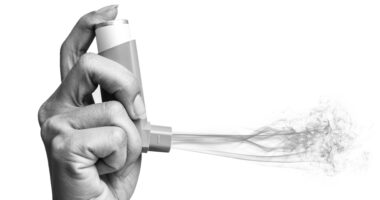Scientists Compute How to Boost Effectiveness of Inhaler Therapy

Smaller particles and optimal inhalation speed of inhaler treatments — a mainstay for people with chronic obstructive pulmonary disease (COPD) — enhance their delivery to deep airway passages, a study shows.
The study, “Computational evaluation of drug delivery in human respiratory tract under realistic inhalation,” was published in the journal Physics of Fluids.
Increased air pollution in recent years is linked with a rise in health risks, particularly for those with pulmonary diseases such as asthma or COPD. Such increased risk underscores the importance to boost the effectiveness of standard delivery devices, including inhalers, for medicines to ease respiratory symptoms.
In fact, the efficacy of inhalers “remains a great concern as only one-third of the total drug reaches the affected regions of the lungs,” Suvash C. Saha, PhD, from the University of Technology Sydney, Australia, and a co-senior author of the study, said in a press release. “As a result, the drug loss and cost of the treatment become higher.”
In the study, researchers from India and Australia developed a computational model to assess the effectiveness in delivering the medicine of choice using pressurized metered-dose inhalers and dry powder inhalers in a realistic human lung model.
Specifically, the team used computation fluid dynamics to analyze flow rates and the deposition of drug particles.
The analysis revealed that at higher flow rates, therapeutic particles of larger sizes were deposited in the upper portion of the airways but were less available in the deeper airways.
“At higher flow rates, inertial impaction is found to be responsible for deposition of drug particles in the upper portion of the airways but with lesser availability of drug particles in the distal region of the airways,” said Akshoy Ranjan Paul, PhD, at the Motilal Nehru National Institute of Technology Allahabad, in India, co-senior author of the study.
The ability of an inhaled medication at lower flow rates to reach the deeper lung regions was even more compromised. These findings suggest that an “optimal” flow rate is required so that therapeutic particles reach the deeper (distal) regions in the lungs.
“At lower flow rates, there is not enough momentum to carry particles to the distal region,” Paul said. “As a result, there should be an optimum flow rate [to achieve] maximum reach of drug particles in the distal region.”
Furthermore, the model showed that a higher number of particles are deposited in the right airway passages, also called bronchi, than in the left ones.
“Left bronchi are relatively curved as compared to right bronchi due to the presence of the heart, which is responsible for the lesser entry of the air and the particles,” the researchers wrote.
Overall, the findings suggest that the design of effective therapeutics for inhalers requires considering “the relationship among particle size, inhalation rate, and efficiency of drug deposition in different regions,” the researchers wrote.
Therapies composed of smaller-sized particles could boost their ability to reach the deep areas of the lung, according to the team.
This research “is a notable example that demonstrates how the understanding of fluid mechanics, and the power of computational fluid dynamics, can inform more effective design of drugs and drug-administering devices,” Saha said.







